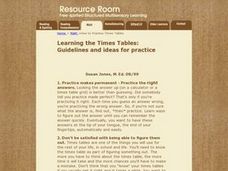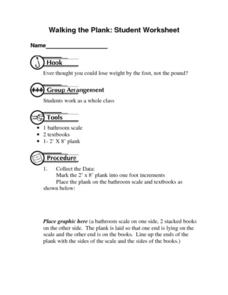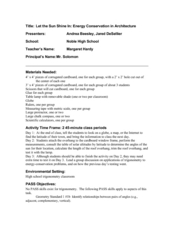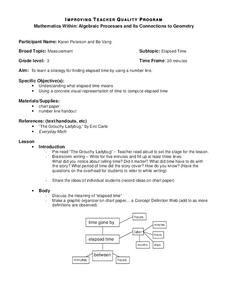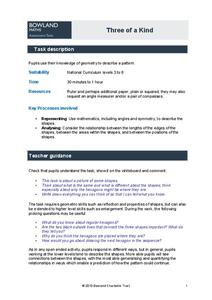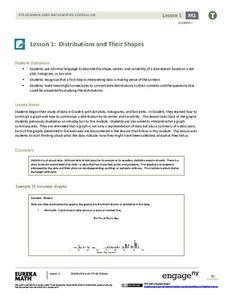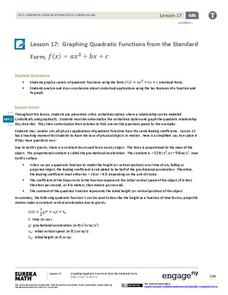Curated OER
Learning the Times Tables: Guidelines And Ideas for Practice
Students observe and demonstrate a variety of techniques for learning their times tables. They check their answers on a calculator, create flashcards and a number line, develop a number chart from 1-100, write times table story...
Curated OER
Digit Cells
In this algebra worksheet, students rewrite a word problem using algebraic symbols to find the digit in the first cell and tell how many zeros are in the entire digit number. There is an answer key.
Curated OER
Walking the Plank: Student Worksheet
In this math worksheet, students will work in a group to experiment with the weight of objects when placed at a distance from a scale (using a plank). Students will record and graph their results.
Curated OER
Natural Inspiration
Students relate math to the real world. In this algebra lesson plan, students compare plants to math and relate their artistic ability to concepts in math. They draw pictures of flowers, leaves and trees.
Curated OER
Spaghetti Bridges: Student Worksheet
In this math worksheet, students will create a "bridge" out of spaghetti and test it's strength with pennies. Students will record their results on a table and then graph the results.
Curated OER
Let the Sun Shine In: Energy Conservation
Students create a project applying their math skills as they discuss energy conservation. In this geometry lesson, students define vocabulary relating to the environment and energy conservation. They construct a building that allow lots...
Curated OER
The Scale
In this secondary mathematics worksheet, students solve a problem in which three boys weigh themselves two at a time. Students use the given weights to deduce the weight of each individual. The one page worksheet contains one...
Curated OER
Problem-Solving Strategy: Act It Out
In this mathematics worksheet, 1st graders identify what time the concert starts and ends. Then they use a clock to act out the time and draw the hands on the clock to show when the concert will be over.
Curated OER
How Many in a Minute
Students estimate what they can accomplish in a minute. For this estimation lesson, students guess how many jumping jacks or stars they can draw in a minute. They get timed and see how close they are to their prediction.
Curated OER
Measurement
Third graders explore a strategy for finding elapsed time by using a number line. They identify what elapsed time means. Students investigate a concrete visual representation of time to compute elapsed time. They read, " The Grouchy...
Curated OER
Half An Hour Later
In this time worksheet, students look at the times shown on both digital and analog clock faces. They make the clock next to each one show a half-hour later. They tell if the hour hand is closer to the 3 or 4 when it is 3:30 while...
Curated OER
Clock Worksheet
In this clock worksheet, students are given a time and asked to draw the hands on the clock to represent that time. Students are given 9 problems to practice the skill.
Curated OER
Clock Worksheet
In this clock worksheet, students are given a time and asked to draw the hands on the clock to represent that time. Students are given 9 problems to practice the skill.
Curated OER
Functions and Graphing
Graphing functions in a real world application makes math come to life. Learners graph points on a coordinate plane and identify various points on a graph by working through a set of real world problems. This is a perfect review exercise.
Curated OER
Prepositions Can Show Positions in Time
Who knows where or when? The preposition knows! Young grammarians are asked to identify the preposition and the connecting prepositional phrases in 16 sentences. An answer key is provided.
Curated OER
NFL Home Field Advantage?
Does the home team have the home field advantage in football? Class members look at a graph that displays wins at home and wins on the road for each NFL team from 2002–2012. Then they answer eight word problems that look at the...
Bowland
Three of a Kind
One is chance, two is a coincidence, three's a pattern. Scholars must determine similarities and differences of a regular hexagon undergoing dilation. They look at lengths, angles, areas, and symmetry.
Willow Tree
Formulas
Help learners understand the benefits of rearranging a formula. Scholars practice rearranging formulas for specific variables. They also analyze formulas to understand one variable's effect on the other.
Mathed Up!
Mean, Median, Mode, and Range
Learners read a variety of word problems and find the mode, median, range, and mode from a given set of data. If calculators are not desirable, provide the class with notebook paper to work out the equations.
Federal Reserve Bank
Your Credit Report
What is your credit score? How do you find it? Help your pupils answer these questions and more. They will access their free credit report and then analyze its meaning.
Mathed Up!
Mixed Transformations
Viewers learn how to identify and perform a variety of transformations with a video that provides seven items on transformations. Pupils demonstrate their understanding of dilations, reflections, rotations, and translations. The video...
EngageNY
Distributions and Their Shapes
What can we find out about the data from the way it is shaped? Looking at displays that are familiar from previous grades, the class forms meaningful conjectures based upon the context of the data. The introductory lesson to...
EngageNY
Graphing Quadratic Functions from the Standard Form
Use context to explain the importance of the key features of a graph. When context is introduced, the domain and range have meaning, which enhances understanding. Pupils use application questions to explore the key features of the graph...
Bowland
Public Transport
"Statistics is the grammar of science" -Karl Pearson. In the assessment task, learners read a claim made by a newspaper and analyze its conclusions. They need to think about the sample and the wording of the given statistics.
Other popular searches
- Esl Math Telling Time
- Esol Math Telling Time
- Math Telling Time Worksheets
- Math Telling Time Activities
- Telling Time Math
